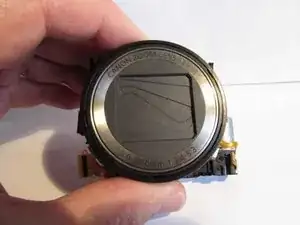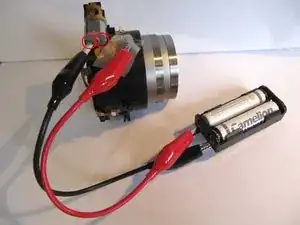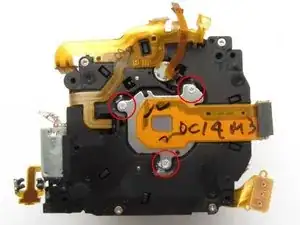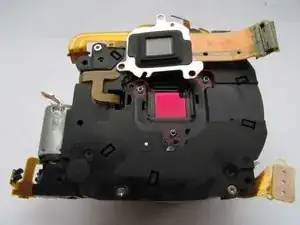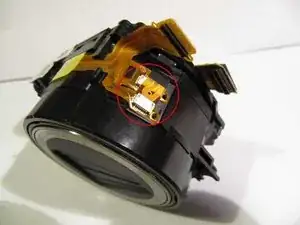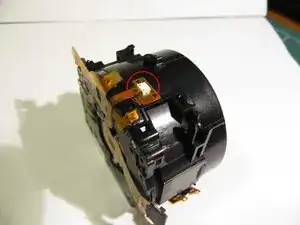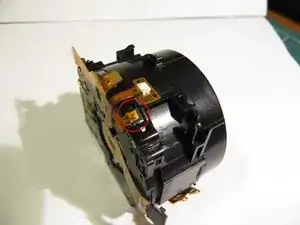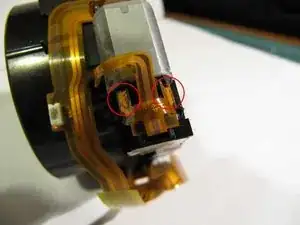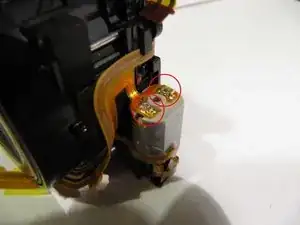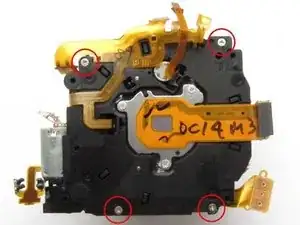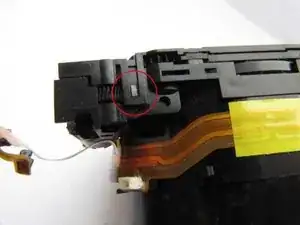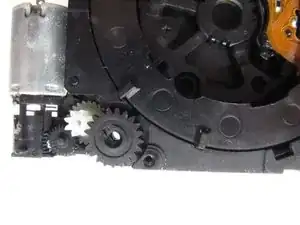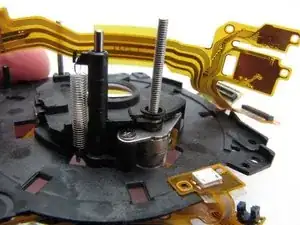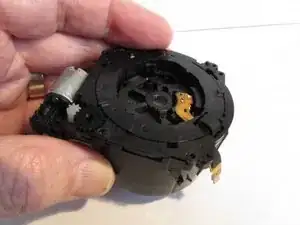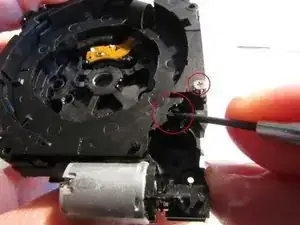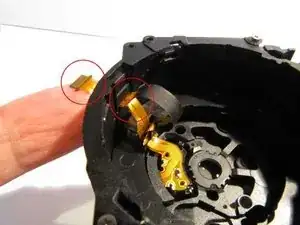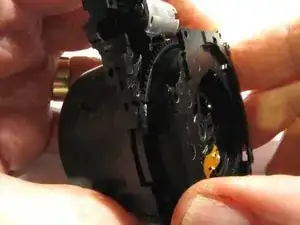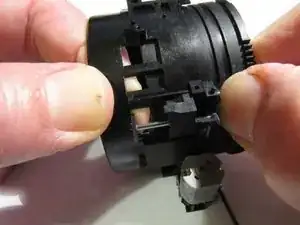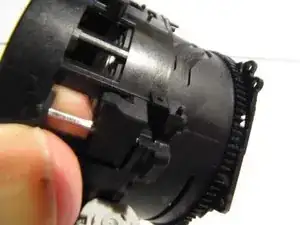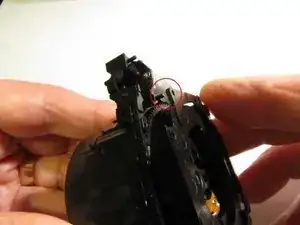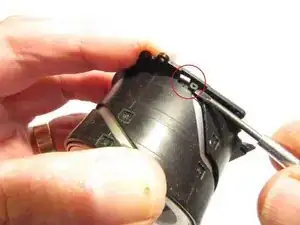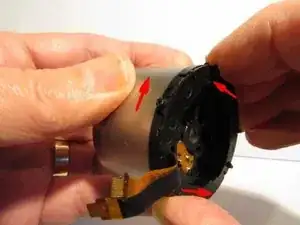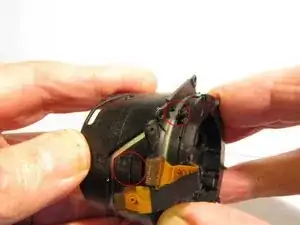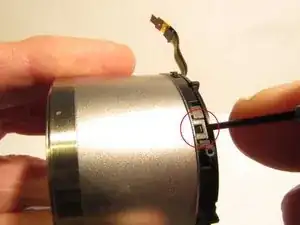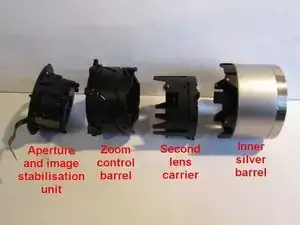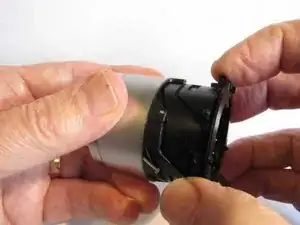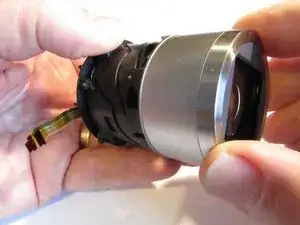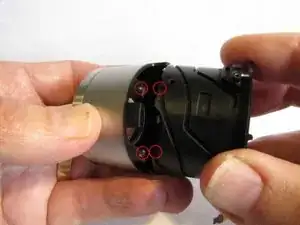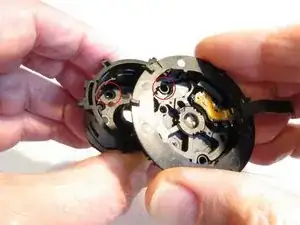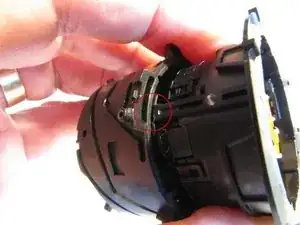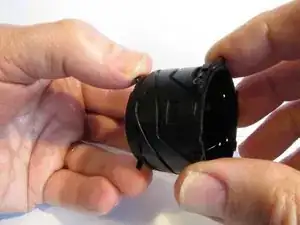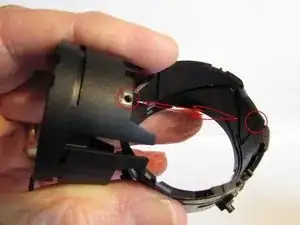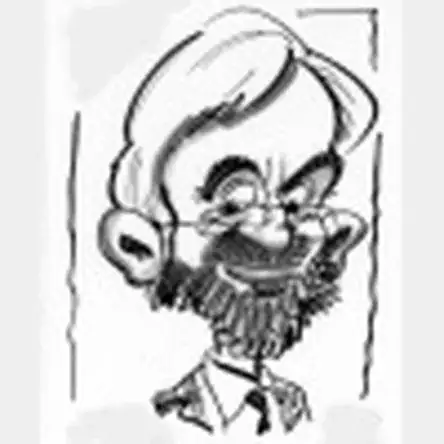Einleitung
Disassembly and reassembly of this lens is not difficult so much as requiring a fair amount of patience.
Note that it is very easy to get fingermarks or dust on the optical components but much harder to completely remove them. Particularly on the focussing lens and the image sensor, any contamination will have a significant or major effect on image quality.
Note also that "left", "right", "clockwise" and "anticlockwise" in this guide are always as seen from the photographer's point of view behind the lens, unless specifically stated otherwise. Bear in mind that the correct orientation of components is essential for reassembly. This is very easy to loose track of, which will result in much wasted time in trial and error.
You will need small cross-head and flat screwdrivers and a small craft knife. Additionally, a pair of fine tweezers will be helpful, and cocktail sticks are useful for releasing ribbon cables from their sockets. If you need to clean the optical components you will need some isopropyl alcohol and non-linting cotton swabs or lint-free cloths. Unless your eyes can focus at distances less than 10cm a magnifying glass or jeweller's eye loupe will be very helpful.
On reassembly, the plastic gears, guides, guide grooves and sliding surfaces may be lubricated if necessary with a smear of silicone grease, but take care not to get any on the contacts of any of the ribbons.
This guide is directly applicable only to this one specific model, nevertheless, other Canon compact camera lenses follow similar principles of operation and methods of construction. Disassembly of a Canon A3150IS lens has confirmed this. In that case the main differences were that (a) it's significantly smaller, and (b) the image stabilisation ribbon (Step 9) is non-detachable. Both these factors make it more difficult, and in the case of that particular lens a very thin and narrow section of plastic in the second lens carrier was broken, a problem that a larger lens would be less susceptible to.
Further background information on a similar Canon lens is given in the CHDK Forum at http://chdk.setepontos.com/index.php?top...
Werkzeuge
-
-
Before starting disassembly or on completion of reassembly it is highly recommended that you test the lens.
-
Gently lift the ribbon cable connections off the two tags on the back of the motor.
-
Apply power to the motor from a 3v battery pack by connecting it to the two tags on the motor. Apply positive to the terminal to the front of the lens to extend it, or to the back of the lens to retract. (Keep all ribbons out of the way - applying power inadvertently to the wrong place could damage something.)
-
-
-
Skip to Step 4 unless you specifically need to examine the sensor as any dust or fingermarks may have a major impact on image quality and correct realignment on reassembly is critical. It should therefore preferably be left alone. The image sensor and infrared filter can be inspected or replaced without further disassembly of the lens.
-
With a small craft knife, scrape away the locking glue from the 3 screws securing the image sensor plate to the back of the lens. Take care to remove any loose fragments of glue which might fall into the lens.
-
Note the initial positions of the heads of the 3 screws and remove them, counting the number of turns required for each. Remaining glue will make these stiff - take care not to burr the heads. Gently ease the image sensor away, keeping the lens face-down on the bench.
-
Put the sensor aside, safe from dust contamination, such as in a self-sealing polythene bag.
-
-
-
With the image sensor plate removed, three tiny springs will be seen in the lens back plate. These are very easily lost. Remove them with fine tweezers and put them somewhere safe.
-
A very thin coated glass infrared filter will fall out if the lens is inverted. On no account touch it with your fingers. It may be cleaned if necessary, however this is unlikely as the rear face is sealed from dust except during disassembly and the front face is normally protected by the focussing lens in its rest position.
-
The infrared filter may be replaced by a red filter if your aim is to convert the camera for near-infrared use.
-
The image sensor itself should not need cleaning unless contaminated while disassembled. Should it be necessary, first peel off the rubber surround. On reassembly, do not attempt to reattach this to the image sensor plate but rather place it over and around the glass window.
-
On reassembly it is important for accurate focussing that the 3 screws are each tightened by the same number of turns and to the same positions as before disassembly. Apply screw locking compound to the heads to prevent movement.
-
-
-
On the lower right hand side of the lens, disconnect two ribbons from their sockets, one on top of the other.
-
(These ribbons connect to the image stabilisation cell and the iris.)
-
Disconnect a ribbon from its socket on the top of the lens.
-
(This ribbon connects to the focussing motor.)
-
Using a small flat screwdriver or a pin (not a knife), very gently scrape away the mastic from the focussing lens position sensor on the top of the lens, and ease the sensor out.
-
On reassembly, secure the sensor with a drop of nail varnish or hot melt glue applied with a cocktail stick. (A glue gun is likely to dispense far too much if applied directly.) Cyanoacrylic glue is not recommended as there have been reports that the fumes can fog lens coatings.
-
-
-
In a similar fashion to the focusing lens position sensor, gently scrape away the mastic from the two sensors on the front of the zoom motor, and lift the sensors out.
-
On reassembly, secure the sensors as for the focusing lens position sensor.
-
Lift the two connectors off the back of the zoom motor.
-
Release the ribbon from all the pegs and guides holding it to the lens body. It should now only be attached to the lens back plate.
-
-
-
Remove 4 screws from the lens back plate, release a catch at the bottom, and lift off the lens back plate.
-
(On reassembly, take care to engage the focussing motor leadscrew and guides in the holes provided for them.)
-
Note the order and position of the zoom gears for reassembly.
-
(On reassembly, fit the middle gear first.)
-
-
-
On the back plate, turn the focus motor leadscrew clockwise with your fingers and check that it reliably lifts the focus lens. The leadscrew engages in a threaded brass insert in the plastic piece holding the focus lens.
-
On a well worn camera the thread in the brass piece can fail resulting in a failure to focus. Unless you have access to watchmaker's machine tools, the only solution is to obtain a spare from another lens with a different fault.
-
-
-
Note: from here on reassembly is critically dependent on the correct alignment of parts. It is highly recommended that you practice disassembly and reassembly of each stage several times before going on to the next.
-
If you find things don't fit, don't panic, check the orientation, fiddle it bit, and if necessary, put it aside and come back tomorrow. With patience, it will go back together again!
-
-
-
With the lens back plate removed, temporarily replace one of the 4 screws which secured it. It will not be possible to drive it fully home; only tighten it until resistance is felt.
-
Lift out the three zoom motor gears and put them aside.
-
Lift the lens off the bench and using a small flat screwdriver, gently turn the gear teeth which the last zoom motor gear engaged with until the lens is open approximately half way.
-
Now feed the two ribbons protruding through a slot in the barrel back into the lens.
-
Resting the lens face-down on the bench, retract it to the closed position by turning the gear teeth in the opposite direction. Remove the screw you temporarily reinserted.
-
Follow the reverse procedure for reassembly.
-
-
-
Lift the innermost black lens barrel section away from the section with the gear teeth, which remains still engaged with the outermost section.
-
Rotate the geared section clockwise within the outermost section as far as it will go. This causes the flash head actuator to move forwards, then allowing the geared section to be partially withdrawn.
-
The geared section can now be completely withdrawn by squeezing the geared section and stretching the outermost section so as to allow two pips in the flash head actuator to disengage from the grooves in the geared section.
-
-
-
To reassemble, first fit the geared section to the outermost section, ensuring that the pips in the flash head actuator are engaged in the grooves in the geared section.
-
Turn the geared section fully clockwise within the outermost section and insert the inner sections with the screw holes lining up. Two pegs in the outermost section, one adjacent to the motor and the other almost diametrically opposite, should line up with their holes in the flange.
-
If necessary, rotate the gear teeth by no more than one or two teeth in order to get it to fit. Expect to have to do a bit of fiddling and to try several times before it goes together. No force is needed.
-
Temporarily insert one of the 4 screws to hold it together while you extend the lens in order to feed the ribbons through their slot. Close the lens again before fitting the back plate.
-
-
-
To remove the lens core from the innermost black barrel, push one of three pegs towards a slot in the flange. With light pressure on the front of the lens (but not on the protective lens shutter), all three pegs will pop through their slots, allowing the lens core to be removed.
-
To reassemble, ensure the lens is fully closed. Hold the silver barrel in the fingers of one hand and rotate the rearmost component anticlockwise against spring pressure with the fingers of the other hand. Extend the grip of the fingers of that hand to hold the lens against the spring.
-
Ensuring the slots in the innermost barrel through which the ribbons have to pass are roughly aligned with the ribbons, and insert the silver barrel into the innermost black barrel. Once the pegs are in the slots they came out of, allow the spring pressure to feed the pegs into their channels.
-
-
-
To remove the outermost silver barrel, release three clips with a small flat screwdriver. Lift each only sufficiently to release it whilst easing away the back flange, and try not to let it revert while you tackle the next clip.
-
On reassembly, the outer silver barrel can go one of three different way. It doesn't appear to matter which. Simply click the three clips home.
-
-
-
Disassembly of the lens core is easy but reassembly is harder, simply because of the many possible wrong orientations of the components. Follow the remaining steps very carefully.
-
The lens comprises four components: the inner silver barrel which holds the first lens and the protective shutter, the second lens carrier, a zoom control barrel, and the aperture and image stabilisation unit.
-
The zoom control barrel is the only one of these which rotates. The others slide in and out, controlled by pins located in helical slots.
-
The engraved bezel on the front of the inner silver barrel can be eased off to reveal the lens cover mechanism but would be easily bent in the process and would have to be glued back on.
-
-
-
Holding the inner lens barrel in one hand and the flange of the aperture and image stabilisation unit in the other, pull gently to extend the lens to its open but un-zoomed state. Notice that the zoom control barrel will rotate anticlockwise.
-
Rotate the zoom control barrel further to the fully zoomed position. Six pins in the inner silver barrel will now have reached the end of their helical grooves, allowing the inner silver barrel to be lifted off.
-
On reassembly, there are 6 possible orientations of the inner silver barrel. Facing the front of the lens and with the engraving on the lens the correct way up, the aperture and image stabilisation ribbons should be at 8 o'clock.
-
Ensure the 6 pins on the inner silver barrel are correctly inserted into the ends of their grooves and rotate the zoom control barrel to close the lens. Ensure that it closes all the way, resulting in the protective shutter closing.
-
-
-
The aperture and image stabilisation unit will now lift out of the zoom control barrel.
-
On reassembly, note a hole in the aperture and image stabilisation unit and a depression in the second lens carrier, located in the zoom control barrel. These need to line up. Three fingers on the aperture and stabilisation unit slide into slotted fingers on the second lens carrier.
-
-
-
Holding three pegs on the front of the second lens carrier in one hand, rotate the zoom control barrel as far as it will go. It will now slide off the second lens carrier.
-
On reassembly, there are three ways the second lens carrier can be fitted into the zoom control barrel, and on this occasion it doesn't appear to matter which you choose.
-
Locate the three pins in their slots and rotate to the opposite end of travel.
-
6 Kommentare
In order to clear dust from inner side of the front lens, which steps can be skip/. thanks
Don't do steps 2 & 3 unless you've tried everything else and are ready to scrap the camera. Take it to step 7 then clean the optical surfaces you can see, and maybe remove the focussing lens in order to clean its rear surface, and the front of the IR filter. Bear in mind though that it's hard to remove the last specks of dust on account of static and very easy to add more. If using liquid lens cleaners it's hard to remove the last smears and you could damage the coating.
Having taken it to step 7, complete disassembly (if necessary) is fairly easy, but on reassembly you need to follow the instructions with great care in order to get the correct alignment of the parts - otherwise it just won't go together.
Thanks for the advice. As yet I haven't tried, haven't found exclusive time to consider that. Will take it up during the end of year break and will update on how well it went... Best
How to open the front barrel lens i Canon Powershot SX160IS there is a 1mm white spec inside of the front element
www.youtube.com/watch?v=ZixMpr7u2dE It looks easy for the Canon SX220 lens shown on the video
